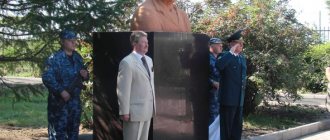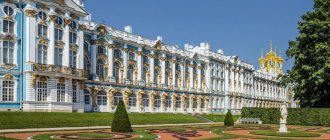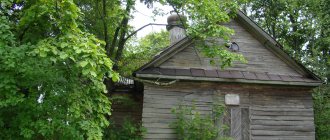Opochka: areas, recreation, excursions, museums and churches, cuisine and restaurants, shopping and shops, attractions of Opochka.
- May tours
to Russia - Last minute tours
to Russia
The city of Opochka, the administrative center of the Opochetsky district of the Pskov region, grew out of a fortress founded in 1414 on a bend of the Velikaya River. The fortress more than once served as a good defense against attacks by the Lithuanians and Germans, but gradually lost its defensive significance due to the expansion of the borders of the Russian state.
The name of the town is associated with the word “opoka” - “chalk limestone, white clay, alabaster.” And there is some truth to this: limestone stone from the bottom of the Velikaya River was used to lay the fortress.
How to get there
The M20 highway St. Petersburg - Pskov passes through the city, the distance from St. Petersburg is 412 km, from Pskov - 137 km.
By public transport you can get to Opochka like this: train to Pskov, then by bus for about two and a half hours; There are many routes through the city, so you don’t have to worry about missing your flight. In addition, you can take a bus to the Pushkin Mountains, bypassing Pskov, and then take the Pushgory - Opochka bus, which, however, is less convenient.
Search for flights to Opochka at minimal prices
Opochka
(Pskov region)
OKATO code:
58229501
Founded:
1414
City since:
1414 City of district subordination (Opochetsky district, Pskov region)
Center:
Opochetsky district
Telephone code (reference phone)
| 81138***** | 92-2-22 |
Deviation from Moscow time, hours:
0
Geographic latitude:
56°43′
Geographic longitude:
28°39′
Altitude above sea level, meters:
90 Sunrise and sunset times in the city of Opochka
A little history
In the 18th and 19th centuries, the city was one of the most important trade and craft centers in the Pskov province; Opochets fairs were famous far beyond its borders. In addition, Opochetsky district was famous for the fact that it was here that the estates of Count Yaguzhinsky, the Prosecutor General of the Senate, the Lvov princes, Count Razumovsky, the favorite of Elizabeth Petrovna, were located. The latter, by the way, eventually passed to another favorite, Potemkin-Tavrichesky.
Aristocrats and favorites not only enjoyed a calm and measured life in the provinces, but also opened factories and factories on their lands: linen weaving, carpet, sailing. And the merchants looked after the interests of their small homeland. Thus, 1910 was marked for Opochka by the appearance of motor transport: local merchants purchased a bus, which began to operate flights to Ostrov and Pustoshka.
Institute for Problems of Modern Society
Opochka. The central square of the city is devoid of markings and lighting.
Recently my family and I moved to the Pskov region, to the Opochetsky district. By profession, I am an economist-analyst, I work remotely, via the Internet (fortunately, modern technologies allow this), I head a public organization called “Institute for Problems of Modern Society.” Based on official statistics, we analyzed the situation in the districts of the Pskov region.
In all areas except the Pskov region, the population has decreased since 2009. The reason is quite clear: the Pskov region is far from the most successful region in terms of socio-economic development. There are no jobs in the areas, low wages, and an older population. Young people are leaving and old people are dying.
But it is surprising why the population outflow is so uneven. For example, why is the population declining so rapidly in the Porkhovsky, Strugo-Krasnensky and Opochetsky districts, although the official salary in these areas is at the level of the regional average? Maybe because man does not live by bread alone, and in these areas there are other problems that could be solved at the local level, but they don’t want to solve them?
Apparently, this is exactly the case. Local authorities are not at all interested in retaining the population. The fewer people in the area, the fewer claims, questions and complaints, the fewer problems officials have.
But people still go. The Pskov region is an extremely beautiful region with a centuries-old history, with sympathetic and kind people, with beautiful nature, and also located near Moscow and St. Petersburg. That's why people continue to come here, although local authorities are not happy to see them.
Local authorities always complain not about a lack of money. But the question is whether the money is really being spent for the benefit of the people. And how effective are these expenses? And why in some areas the authorities somehow manage to make life better, but in others they fail.
For example, Opochetsky district is one of the ten most affluent districts of the Pskov region in terms of budget expenditures. The area is so “prosperous” that the local authorities last year had as much as 4.3 million rubles of “extra” money left! The local budget received 253 million rubles from various sources, but only 249 million were spent. But with this unspent money, a lot of useful things could be done for the area!
But the costs of municipal officials in the Opochetsky district are noticeably higher than the regional average. Local authorities are not depriving themselves!
Municipal authorities also often complain that the local budget is very dependent on interbudgetary revenues, while its own budget revenues are minimal. This is not entirely true.
For example, in the Opochetsky district, the share of own tax and non-tax revenues in 2016 amounted to 36% of total revenues. This is one of the highest indicators in the Pskov region! Local residents alone brought 28 million rubles in taxes in the form of personal income tax to the district budget. Small businesses paid almost 14 million rubles in taxes in the form of UTII. So the contribution of local residents to the budget is quite significant. And they have every right to demand an account of funds spent from the municipal budget.
One of the main responsibilities of municipal authorities is control over housing and communal services. It is clear that in an area with predominantly private development and a minimal length of utility networks, these costs are small. But there are many similar districts in the Pskov region, why are the costs for housing and communal services in the Opochetsky district some of the lowest in the region? Even in the neighboring small Krasnogorodsky district, the authorities spend one and a half times more on utilities.
One of the most opaque budget items is roads. It is extremely difficult to monitor the effectiveness of expenditures under this item, but the possibilities of “writing off” funds and corruption there are limited only by the dishonesty of officials.
In the Opochetsky district, these expenses are simply colossal: in 2015 - almost 42 million rubles, in 2016 - slightly less than 48 million. In 2015-2016, Opochetsky district consistently ranked 2nd in terms of road construction expenditures among all districts of the region.
Local authorities could even be praised. If not for one “but”. There is no real improvement in the condition of the roads. Even in Opochka itself there is no normal asphalt or sidewalks. Not to mention the country roads.
Of course, some work is underway. For example, the same pothole repair. When asphalt mixture is poured into the holes without even compacting it. As drivers say, “there was a hole - there was a bump.” And after a couple of weeks, this asphalt mixture simply flies out of the holes. Just like 100 million rubles of our money went down the drain.
Just think, almost 100 million rubles in two years! But have you noticed any real improvements in the condition of the roads?
At the same time, Opochetsky district is among the top ten “leaders” in the number of settlements that do not have regular bus service.
Local authorities do not have funds for lighting. Already by 2015, the Opochetsky district was listed in the region as one of the least illuminated. From 2007 to 2015, the length of illuminated streets decreased by 135 km! This is the largest reduction among the districts of the Pskov region.
Local authorities report that 76.5 km of streets in the area are illuminated. This is only 20% of the street network, while the average illumination in the Pskov region is about 30%. Moreover, where these illuminated streets are located, for which the authorities reported to the federal center, is unknown. After sunset, the area is completely dark in the truest sense of the word.
In Opochka, everyone knows the story when a teenager was hit and killed by a car in the central city square in the pitch darkness of the night. Meanwhile, lighting is entirely the responsibility of local authorities. They are obliged to provide street lighting and find resources for this!
But local authorities find 100 million rubles for roads, can afford a surplus of 4.3 million rubles, but for some reason they cannot find money for the safety of their residents. Or maybe there is money in the budget for these purposes? Are we the only ones who don't know about this?
The deputies who adopted the budget remain silent. We raised the issue of covering the city on the Internet in the official Opochka group. None of the current deputies left any comments. Apparently they have nothing to say to voters.
Perhaps because they consider themselves the local “elite”, not obligated to communicate with the people. After all, the official incomes of the majority of current deputies are higher than those of ordinary opochans.
I urge you to come to the polls and evaluate the work of local deputies. Are they worthy of being re-elected for another term? After all, they are the ones who decide the budget. It is to them that the administration reports for the funds spent. Unlike ordinary citizens, deputies have the opportunity to study the budget and ask questions about ineffective spending of funds. But for some reason these questions are not asked. Deputies can influence local authorities through parliamentary requests and by initiating prosecutorial checks. But for some reason they don't do this.
Perhaps at work or in the service you will be asked to go to the polls and vote for the “right” candidate. Definitely go. Just remember: you are alone in the voting booth. Both with the ballot and with your conscience. Vote as she tells you. No one except you will know which candidate you have ticked - the one who was “recommended” to you, or the one who you really consider worthy of representing your interests. You don't have to tell anyone who you actually voted for. Say what is beneficial and convenient for you. Why upset your boss or people on whom you somehow depend? Let there be a surprise for them!
Believe me, your vote in this election really matters. After these elections, serious decisions will be made at the federal level. It is through these elections that the federal authorities will assess the real mood of the population and their willingness to endure further. If you don’t want to endure anymore and want change, come to the polls.
All data presented are official figures that local authorities submit to the federal center. If the numbers seem unreliable to you, the question is no longer for us, but for the local authorities, why they are lying to both the federal center and the population.
If you have any questions, you can always contact me by phone +7 or VKontakte .
Olga KIUTSINA.
Entertainment and attractions in Opochka
Opochka escaped the fate that befell many small Russian towns, and there are many historical buildings left here that survived the war and the difficult post-war period. For lovers of antiquity, the remains of the Opochetsky Wall, which once served as a city fortification, are interesting. The Church of St. John the Evangelist, the Church of the Intercession of the Mother of God, the Church of the Finding of the Head of John the Baptist, the Chapel of St. Panteleimon, the Church of St. Olga of Russia, which are located in the city and in the immediate vicinity of it, are of particular interest. In addition, Opochka is considered a convenient point for making radial excursions around the surrounding area.
For lovers of antiquity, the remains of the Opochetsky Wall, which once served as a city fortification, are interesting.
Osipov-Wulf House-Museum
About 45 km separate Opochka from Trigorskoye, a place where the Osipov-Wulf House Museum (close friends of A.S. Pushkin) contains memorial items from the 17th to 19th centuries and a wonderful collection of furniture in the Empire style. Photography is prohibited inside the museum, but the magnificent park surrounding the estate provides excellent backdrops for souvenir photographs.
In the park of the estate you can see those corners that inspired the lines of “Eugene Onegin”; the estate itself was looted and burned in 1918, and subsequently restored after painstaking work with historical materials.
You can visit the attraction from 01.12 to 31.03 and from 1.05 to 14.11 from 10.00 to 17.00 every day, except Monday and the last Tuesday of each month.
Hannibal House-Museum
The Hannibal House-Museum in Petrovsky is open from 01.12 to 31.03 and from 1.05 to 14.11 from 10.00 to 17.00 daily, except Monday and the last Tuesday of each month. His address: Pskov region, Pushkinskie Gory, village. Petrovskoe. This is the estate of the great poet's ancestors. The house was recreated on the old foundation, furnished typologically, since things belonging to Pushkin’s great-grandfather were not preserved. Nevertheless, the extensive and multifaceted collection of household items presented here gives a complete picture of the life of the Russian nobility in the 17th-19th centuries.
Mikhailovskoe
First of all, places of interest in the vicinity of Opochka are those associated with the life of the great Russian poet A.S. Pushkin. About 200 km from the city is the Mikhailovskoye Museum-Estate, the family estate of the poet’s mother. More than once the estate was destroyed and restored, but the museum staff did everything possible to preserve the memory of the great poet for posterity. Unique in the quantity and value of the materials collected in it, the collection of this museum is invariably the focus of attention of tourists from different cities of Russia and abroad. Groups of children and teenagers, Pushkin scholars, people interested in Russian literature come here in the thousands every year. Not only the estate itself, but also its surroundings are worthy of inspection. The local landscapes leave no one indifferent. You can visit the museum daily from 01.12 to 31.03 and from 1.05 to 14.11 - from 9.00 to 17.00, with the exception of Mondays and the last Tuesday of each month.
In the Holy Dormition Svyatogorsk Monastery on the night of February 6, 1837, the funeral service of A. S. Pushkin took place, after which he was buried in the family cemetery near the eastern wall of the monastery. At first there was a simple wooden cross on the grave, and in 1841 a monument by Alexander Permagorov was erected. The monastery is located in the center of the village of Pushkinskie Gory, founded in 1569, and is now an active male Orthodox monastery.
OPOCHKA
OPOCHKA, a city in Russia, in the southwest. parts of the Pskov region, center of Opochetsky district. Us. 10.3 thousand people (2017). Located on the river. Velikaya, 62 km from the railway. Art. Empty. North-east On the outskirts of O. there is a federal highway St. Petersburg - Pskov - Ostrov - Opochka - Pustoshka - Nevel - the border with Belarus.
O. was founded by the Pskovites in 1414 as a result of the transfer of the city of Kolozhe to a new location (it arose no later than the 2nd half of the 14th century; it was located 12 km south of O., on a hill at the confluence of the Kudka River and the Velikaya River), destroyed Lit. troops in 1406 during the Muscovite Lithuania. wars of 1406–1408 (fortified settlement with an area of 0.8 hectares; in its northwestern part there is a cemetery where three stone grave crosses from the 15th–16th centuries have been preserved - unique monuments of the Russian Middle Ages; two of them are now in the historical local history museum O.). In Aug. 1426 O. withstood the Lithuanian-Tat siege. troops under command. Vytautas, on September 1427 – troops of the Livonian Order. On Sept. 1441 O. destroyed by fire, rebuilt in the same year. In 1501, during the Rus.-Litov. wars of 1500–03, withstood the siege of Lithuania. troops. In the fall of 1517, during the Rus.-Litov. wars of 1512–22, large forces of Polish-Litovs. troops under command. book K.I. Ostrogsky besieged O. for 28 days, but its defenders, led by the governor V.M. Saltykov, held out, and then, with the help of Russian detachments that arrived in time. troops defeated the enemy. During the Livonian War of 1558–83, numerous troops were stationed here. Streltsy garrison, O. was a gathering place and rest for Russians. troops. Perhaps in 1580 the Polish-Litovs were taken. troops, but according to the Yam-Zapolsky Peace of 1582 it remained part of the Russian Federation. state During the Time of Troubles in 1612, the inhabitants of O., together with the Sebezh Cossacks, defeated the Polish-Litovs. troops at the Zavolochye fortress and left their garrison in it.
District city of St. Petersburg. (until 1710 Ingria) province. (1708–19), Pskov province. St. Petersburg (1719–27) and Novgorod (1727–72) provinces. Center of the Pskov province (1772–76). In 1772, Belarus passed through O. a path that provided communication with Polotsk. In 1774 the city was seriously damaged by fire. In 1776–1927, a district town in the Pskov province. (in 1777–96 Pskov governorship). In the 18th–19th centuries. O. is one of the leading trade, craft and flax producers. centers of the Pskov province. In 1849, a highway from St. Petersburg to the border with Vitebsk province passed through the city, in 1916 - a railway line. village Pskov - Polotsk (destroyed in 1941–44, not restored). In 1895 gr. P. A. Heyden founded the Opochetsky District Society of Agriculture.
In Jan. 1918 installed owl. power. After the conclusion between the RSFSR and Latv. Republic of the Riga Peace Treaty of 1920 Opochetsky district. became borderline. Regional center of the Pskov region. Leningrad region (1927–30), Leningrad region. (1930–35), Kalinin region. (1935, 1941–44), Velikoluksky district. (1935–37) Kalinin region. Center of Opochetsky district (1937–41) Kalinin region. In Vel. Otech. During the war the city was occupied by Germany. troops from 8/7/1941 to 15/7/1944, heavily destroyed, liberated by units of the Red Army during the Rezhitsa-Dvina offensive. operations. Regional center of Velikolukskaya region. (1944–1957), from 1957 Pskov region. Restored to the beginning. 1950s
Opochka. Technical school building. 1913. Since 2008 Museum of History and Local Lore. Photo by D. V. Solovyov
On an island formed by the river bed. Velikaya and a fortress moat (dug in the 15th century), a fortified settlement (Val; Upper Town) has been preserved (up to 20 m high); Excavations have revealed the remains of gates, church foundations (all from the 15th century), and a gunpowder magazine (late 17th century). The city center with rectangular blocks was built according to a regular plan developed in 1774. I. E. Starov (approved in 1778). On the right bank of the Velikaya, on the site of the burned Lower Town (posad), a rectangular Cathedral Square was organized, on which the baroque 5-domed Spaso-Preobrazhensky Cathedral was built (founded in 1780, built in 1791–92, consecrated in 1795, architect I. Parfyonov; blown up in 1937), classic 2-story public buildings (1775–76, built on in 1937; formerly the House of Soviets, now a professional school) and the city. buildings (barracks) (1775–76, the 3rd and 4th floors were built on in the 1870s), the house of the merchant A. Kh. Telepnev (1830s). Among the buildings in the classicist style is also the house of the Mogilev and Pskov governor general, Count. Z. G. Chernyshev, house of the Pskov governor (both 1775), Pokrovskaya Ts. to the mountains cemetery (1804). All R. – 2nd floor 19th century built trees houses (including merchant houses) of A. V. Korsakov, I. I. Ignatovich, N. I. Kukolkin (2nd floor with neo-Gothic windows, 1870–80s, now the Children's Art School), F. S. Selyugin (1871), etc. Also in the middle. 19 – beginning 20th centuries erected: postal station with neo-Gothic style. windows (1847–54; now a bus station), stone warehouses for flax, wood. Lutheran church in the neo-Gothic style (1871–74; the interior and roof burned down in 2011), the warehouse building of the Telepnev merchants (1891; in 1999–2006 rebuilt into the Church of the Transfiguration of the Lord); building of the zemstvo hospital in the Zavelichye district (opened in 1894; now the central district hospital, with the chapel of Martyr Panteleimon, late 19th century, restored in 2001), technical. school (1913, now the Museum of History and Local Lore). House of Culture (1955; on the site of the Assumption Church, 1891–94, architect A. A. Parland, blown up in 1934). Wooden Assumption Cemetery Chapel (1995) and the Church-Chapel of the Finding of the Head of John the Baptist (2002).
Monuments: hero pilots A. F. Romanenko and S. G. Tsarkov; V.V. Mayakovsky; marble obelisk in honor of the soldiers of the 10th Guards. division that liberated O. from it. invaders (1967). Historical and local history specialist. museum (1977).
Among the large enterprises there is a food factory (production of mayonnaise, mustard), and a bakery. Production of metal products, plastic utensils, clothing, fruit and berry juices and nectars (Stimul enterprise).
Near O., former buildings have been preserved. estates, including in the village. Petrovskoye - “Petrovskaya Manor” (a house on oak stilts was built in the 2nd half of the 18th century by the owner of the estate, Count K. G. Razumovsky; in the 1780s, His Serene Highness Prince G. A. Potemkin-Tavrichesky founded a tapestry here factory); at the Terebeni churchyard - village. c. Resurrection of Christ type “octagon on quadrangle” (1776; 5-tier iconostasis; wooden tented bell tower - 1867, architect I. Puzyrev; in the crypt - the graves of M. I. Kutuzov’s parents - I. M. and A. L. Golenishchev -Kutuzov); in the village Krulikhino – estate of the Lvov princes (mid 19th – early 20th centuries; 2-storey brick house in eclectic style, park with a pond); in the village Matyushkino - the estate of D.I. Golenishcheva-Kutuzova (sister of M.I. Kutuzov) from the village. c. St. Nicholas (1795, restored in the 1990s) and a pond.







